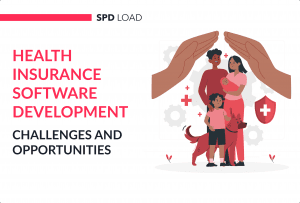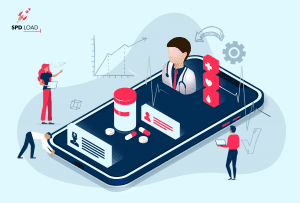Doctor Appointment App Development: Step-by-Step Success
- Updated: Nov 14, 2024
- 17 min
Booking a doctor’s appointment shouldn’t feel like a hassle, but for many, it still is.
Nowadays, we expect convenience and simplicity in every service, and healthcare shouldn’t be left behind.
That’s where doctor appointment apps come in.
These apps are transforming a traditionally time-consuming process into something smooth and efficient.
Doctor appointment apps not only save time but also help avoid double bookings, reduce no-shows, and improve the overall patient experience.
If you’re considering this for your practice, you might be interested in knowing how to build the right appointment scheduling app.
Let’s dive into doctor appointment app development tips and what it takes to build such an app that truly works for both healthcare providers and patients.
We are empowering healthcare innovation through custom apps
What is a Doctor Appointment App?
A doctor appointment app allows patients to schedule and manage doctor appointments online, skipping the need to call.
The main purpose of a doctor appointment app is to deliver a convenient and efficient way for people to book appointments with healthcare providers.
However, healthcare providers also benefit from these applications.
Let’s explore the benefits that doctor appointment mobile apps can offer for patients and healthcare representatives.
Market Statistics and Trends
According to the Research and Markets report, the medical scheduling software market is going to be evaluated at $ 927.09 million by 2028 from $ 435.24 million in 2022.
The estimated CAGR is 13.4% from 2022 to 2028. 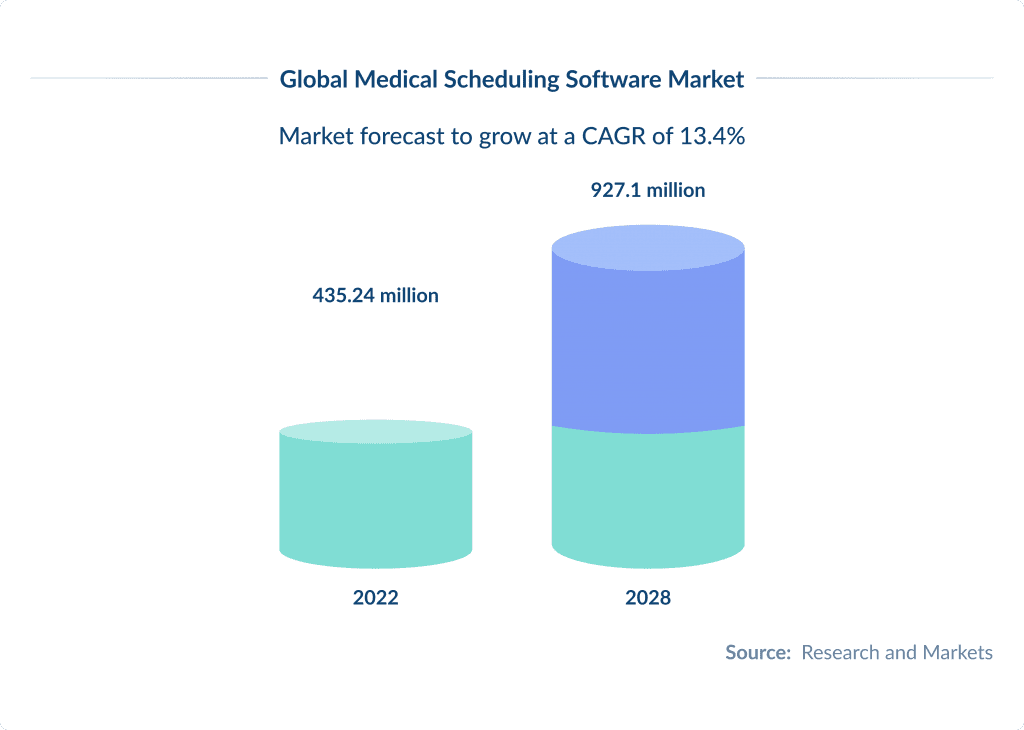
The report shows that medical scheduling software is becoming more popular as healthcare providers focus on making care more patient-friendly.
Online appointment scheduling has become more popular since the COVID-19 pandemic.
Now, people would rather book a meeting or doctor appointment online rather than make a call or visit in person.
In fact, 67% of patients today prefer online booking.
This shift shows that now people more than ever value ease and accessibility.
Businesses should adapt to this trend to enhance customer satisfaction and offer seamless, user-friendly digital experiences.
Make sure your business strategy stays on track with insights from this CLTV calculator — it’s a handy tool for adjusting your approach as needed. 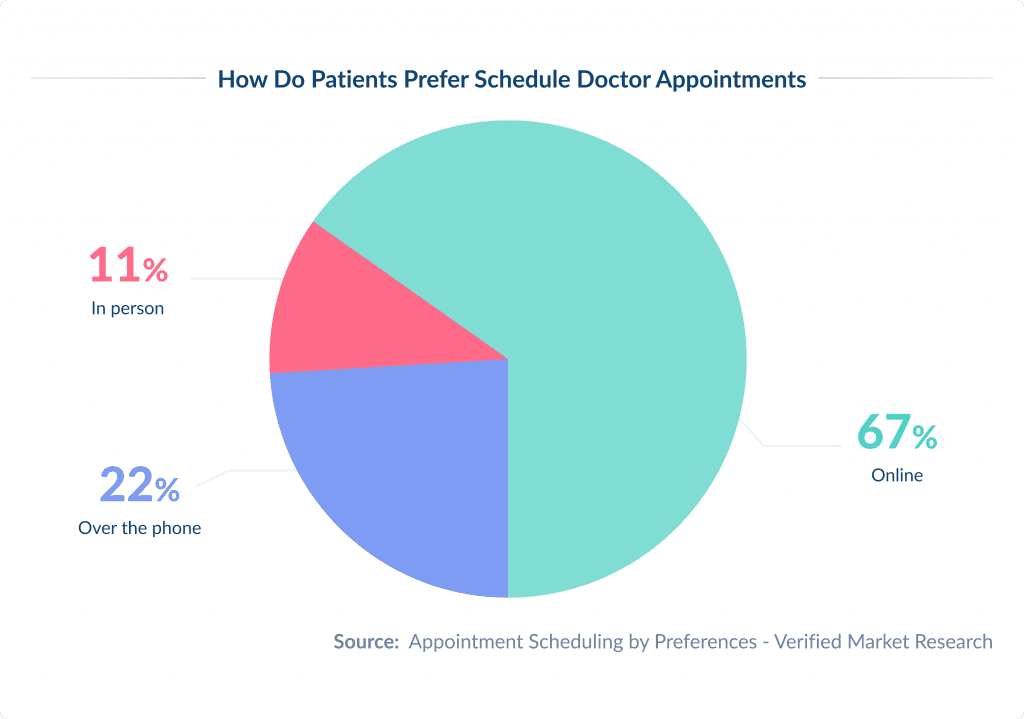
It makes sense, as many people arrange their medical needs during off-hours.
If they have to wait till at least 8 a.m. to schedule an appointment, the chances are high that they will forget to do so or skip their chosen clinic in favor of the most convenient one (i.e., closer to their office.)
Doctor appointment apps eliminate this inconvenience.
Instant visit scheduling contributes to both patient confidence and loyalty.
Another important point is that medical scheduling software is becoming a must-have tool for hospitals as they handle more and more patients.
In 2022, hospitals held the largest share of the scheduling software market, and this is expected to keep growing.
With the rise in chronic conditions like heart disease and cancer, hospitals are busier than ever. They need efficient tools to manage appointments efficiently.
In the U.S., many hospitals are dealing with long wait times.
Sometimes, it takes 26 days just to get a first appointment.
This puts a strain on both patients and healthcare staff.
Scheduling software streamlines appointments, sending reminders, and cutting down on missed visits.
It can reduce no-shows by 30%, so patients get seen sooner, and hospitals run more smoothly. Everyone wins.
As healthcare technology continues to evolve, this type of software will play an even bigger role in helping hospitals deliver better, faster care.
From an ROI outlook, minimizing the cycle of your sales is the central function of appointment scheduling apps.
As online appointment scheduling statistics show, they also lessen administrative works and make report monitoring more accurate for employees.
On top of that, they aid in gaining and keeping customers and optimizing customer, employee, and appointment management.
As a result, businesses can exert their extra time and money on more important matters.
With fewer doctors and nurses available, the software helps make scheduling easier and more efficient.
But, concerns about keeping patient data safe are slowing down its growth.
The software allows patients to book appointments online, even when they’re not at the clinic.
It also sends reminders and helps track appointments, which saves time for both patients and doctors.
When patients are more involved in their care, healthcare providers can offer better service, reduce costs, and improve overall satisfaction.
Find out how healthcare technology trends are transforming patient care and healthcare delivery.
It’s a great step towards making healthcare simpler and more personal for everyone involved.
Doctor appointment apps are a necessity, not just a convenience.
As we can see, the medical scheduling market is growing, and this is a promising era for doctor appointment mobile app development.
More and more users are turning to mobile medicine, raising the demand for a medical appointment booking app.
Curious about where app development is headed? Our application development trends guide has the answers.
Why Develop a Doctor Appointment App?
To better understand why it is a good idea to develop an app for scheduling appointments, let’s explore the key benefits of such an application to healthcare providers and patients.
Advantages for Healthcare Providers
- Increased patient engagement and retention
An app makes managing appointments more efficient by automating the booking process, reducing the need for manual scheduling and phone calls.
- Improved appointment scheduling and management
Automated reminders sent through the app help decrease missed appointments, leading to better time management and less financial loss.
- Enhanced patient communication and feedback
Doctors and staff can communicate with patients through the app, providing updates, answering questions, or offering virtual consultations.
- Increased revenue through reduced no-shows and improved patient flow
The app helps balance patient flow, ensuring doctors aren’t overwhelmed and patients don’t experience long wait times.
Benefits for Patients
- Convenience and time-saving
With an online doctor appointment app, people can book appointments whenever they want.
There is no need to call the clinic, which is ideal for the younger generation.
Research shows that phone anxiety is a problem, for 81% of millennials get apprehension anxiety before summoning up the courage to make a call.
42% of Gen Z representatives say an awkward phone call is one of the top three things they would most want to avoid.
Taking this into consideration, an appointment app is a true lifesaver for many patients.
- Easy appointment scheduling and management
In case a person wants to reschedule or cancel an appointment, it is much more convenient and faster to do so within an app.
- Access to health tips and medical information
Some apps even give access to test results and medical records, making it easier to manage their health.
In short, a doctor appointment app brings convenience, better communication, and more efficient healthcare for everyone involved.
Developing a doctor appointment app can provide a competitive advantage for healthcare providers.
It can help to differentiate them from competitors and improve their reputation.
As AI advances, so does its potential in medicine. Learn how AI and healthcare are shaping the future. 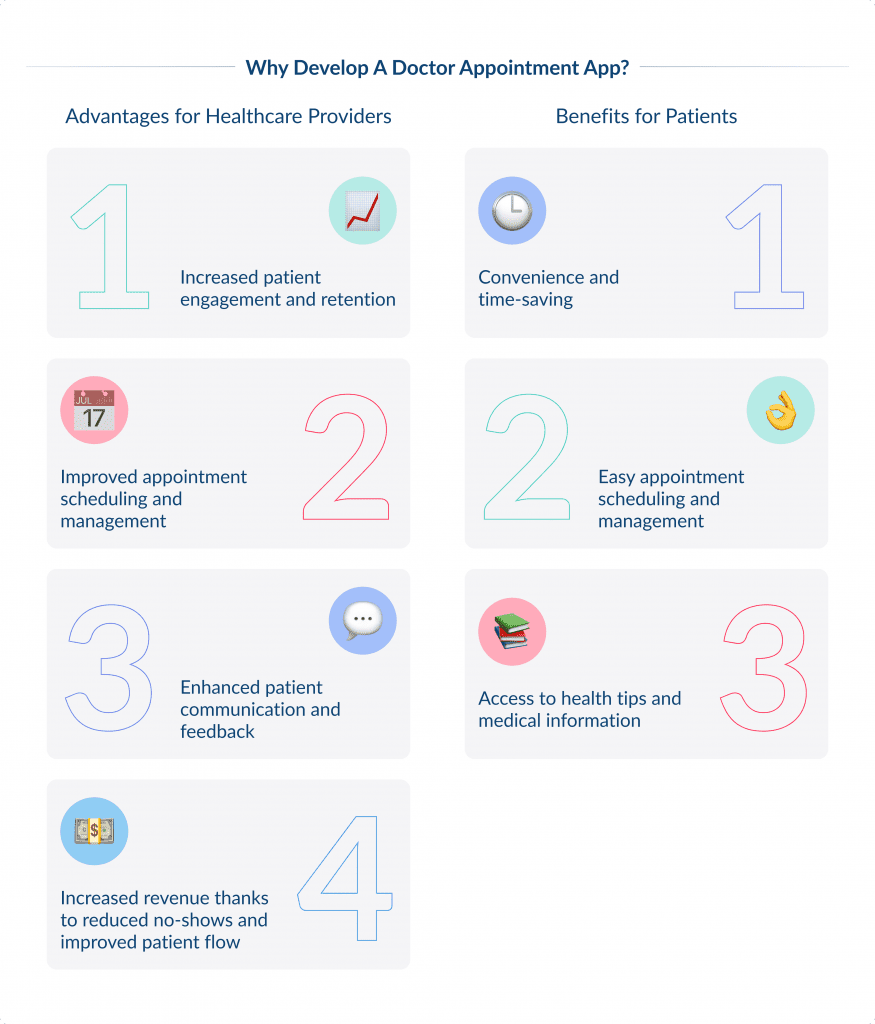
Turning your app idea into reality? Learn how to start an app step by step.
Key Features of a Successful Doctor Appointment App
When creating doctor appointment booking apps, there are key features that enhance its user experience and functionality.
Here’s how these features benefit both patients and healthcare providers:
User Registration & Profile Management
User registration and profile management are the core of any doctor appointment app.
Registration should be easy and guide the patient to input the necessary details.
Patient profiles help to personalize the healthcare journey, so they are a necessity.
Doctor Profiles & Scheduling System
A good doctor appointment app also has detailed profiles for healthcare providers.
These profiles show credentials, specialties and availability.
A robust scheduling system allows patients to make informed decisions and book appointments easily.
These include appointment setting, rescheduling and cancellation processes.
In-App Communication Channels
In-app communication channels are important for patient-doctor dialogue.
Features like chat, video calls, or secure messaging make healthcare more accessible.
If you want to create an app with seamless chats to satisfy your users — check out how to create a messaging app step by step.
Prescription Management & History
In-app prescription management helps build a patient’s health record.
This record includes medication history and allows healthcare providers to issue and manage prescriptions digitally.
Payment Gateway
A secure payment gateway for financial transactions is another must-have feature.
This feature ensures that payments for services rendered are processed smoothly.
Notification
Push notifications are key to keeping users engaged and informed.
A good notification system can increase appointment attendance and user satisfaction.
Patient Reviews & Ratings
Patient reviews and ratings are needed so that users could share their experience and rate the care.
This is important for service quality and provider accountability.
Data Security & Compliance
Data security and legal compliance are required for any app in the medical space.
Implementing robust data protection and adhering to HIPAA and other healthcare regulations is a must.
All online businesses and apps in medical industry should be HIPAA compliant.
With these features, your doctor appointment app will be all-packed to streamline the process of booking appointments, improve communication, and ensure that both patients and healthcare providers enjoy a smooth, efficient experience.
Discover the best HIPAA-compliant chat apps to ensure your conversations meet strict security standards.
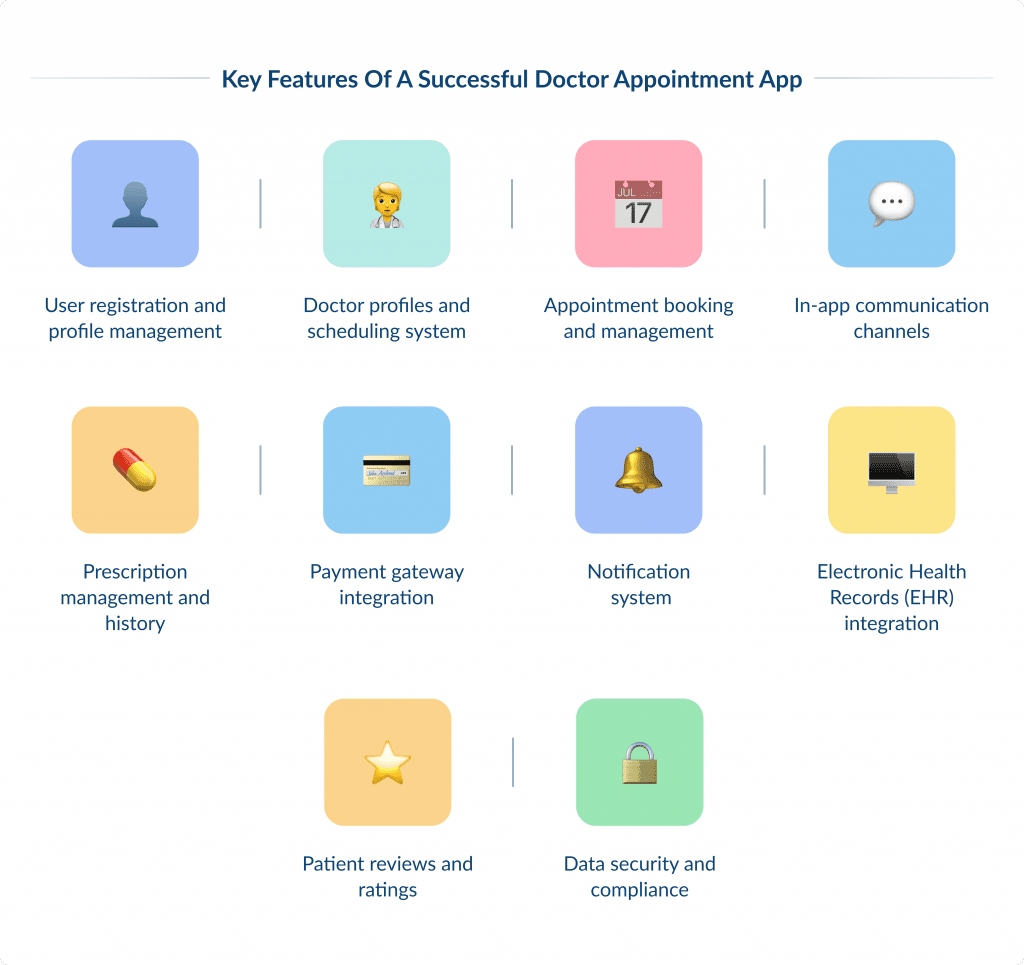
Don’t just create — excel. Learn how to create a successful app.
The Tech Stack: Choosing the Right Technologies for Your Doctor Appointment Mobile App
Another important aspect when it comes to building doctor appointment scheduling apps is the tech stack.
It affects how well the app works, keeps patient data safe, and ensures that the app can grow as more people use it.
With the right tech, you can easily add key features like reminders and secure messaging, making the app smooth and reliable for both patients and doctors.
Frontend/Mobile Development (Flutter, React Native or Native?)
When choosing between Native, Flutter, or React Native app development, you want to think about your needs.
Flutter is a fantastic choice if you want a beautiful and smooth user interface since it comes with lots of custom widgets that make designing easy and fun experience.
If you’re looking to save time and money, React Native lets you write code that works on both iOS and Android, so you don’t have to start from scratch for each platform.
However, if performance is your top priority or if you need to use features specific to either iOS or Android, going with native development (using Swift for iOS or Kotlin for Android) is the way to go. Even though it requires more resources.
Here’s a look at the best iOS app development tools for creating standout mobile apps.
Backend Development Considerations (Node.js, Python/Django or PHP/Laravel)
The right technology for the backend is key to make sure everything runs smoothly behind the scenes.
Node.js shines when you need real-time capabilities, like live chat or instant updates, because it processes requests quickly without delays.
If you’re looking for something easy to work with and great for handling lots of data, Python/Django is a solid choice, as it makes development fast and straightforward.
On the other hand, if you prefer a reliable and well-supported framework for a web-based app, PHP/Laravel is worth considering.
If you’re working with Laravel, these best Laravel tools and resources will streamline your workflow.
Hiring Laravel talent doesn’t have to be hard. Check out this comprehensive guide on how to find a Laravel developer.
Third-Party APIs and Integrations
Adding third-party APIs can really enhance your doctor booking app.
With integrations, you can bring in important features that would take a lot of time to build from scratch.
For instance, APIs can help you include GPS functionality so users can easily find nearby clinics or integrate secure payment systems like Stripe for booking appointments.
With EHR integration, patients and doctors can access necessary medical records instantly. This helps to better coordinate care and streamline consultations. Learn more about how to build EHR software.
They make it possible to access various services, including sending SMS notifications or managing user accounts, without the hassle of developing those features on your own. It keeps things efficient and user-friendly.
Choosing the right EHR system is crucial. Learn more on how to select an EHR that fits your healthcare needs.
Cloud Services and Hosting
Cloud services give you the flexibility to manage your app’s backend more effectively.
Platforms like AWS, Google Cloud, or Microsoft Azure offer tailored solutions specifically for medical services apps.
Discover the strengths and weaknesses of Digital Ocean, AWS, and Google Cloud to find your ideal match.
The solutions include secure data storage and real-time healthcare data analytics.
These services also help ensure that your app can grow with your user base without any hiccups, providing features like automatic backups and compliance with security standards.
Explore the advantages of cloud-based app development to improve app performance and accessibility.
Now that we have discussed the development aspect of doctor appointment app development let’s move on to another important detail.
We are talking about the design.
Designing a User-Friendly Interface for Your Doctor Appointment Booking App
To build healthcare apps that really speak to your target audience, you need to have a deep understanding of the needs of your healthcare app users.
This comes from intense user research, where you gather insights into the users’ behaviors, preferences and pain points.
From this pool of information, you get a structured and detailed view of the many users these apps serve.
Then, you can build features and functionality that match the users’ expectations and medical requirements.
And user needs analysis is a guiding light for developers and designers to build paths that are not only innovative but also understanding of the users’ circumstances and situation.
In short, you need to focus on the needs of healthcare app users.
Explore the potential of healthcare app ideas to make a meaningful impact in healthcare.
Through these processes, you get a user-centric environment where technology is a silent and supportive companion in their healthcare journey.
Explore examples of good web design that combine functionality and creativity
Accessibility Features for All Users
Accessibility is not a feature; it is a fundamental aspect of inclusive design.
It ensures that everyone, including those with disabilities, can easily access and use medical services.
Think about it: 1 in 7 people worldwide live with some form of disability, according to the World Health Organization.
That’s over 1 billion people who will struggle to find healthcare resources if apps aren’t designed with accessibility in mind.
When apps aren’t accessible, they exclude a big chunk of their target audience.
Accessibility isn’t just about following the law like the Americans with Disabilities Act (ADA) in the US.
It’s about equal access to care.
In fact, the US Department of Health and Human Services found that good accessibility features help those with disabilities but also benefit all users, including older adults or those who aren’t tech savvy.
And a study in the Journal of Medical Internet Research found that accessible telehealth platforms led to higher satisfaction and better treatment adherence for patients with disabilities.
This shows how important accessible design is.
Here are some accessibility features to add to the doctor booking app:
- Voice control and speech recognition
- Text-to-speech
- Customizable text size and fonts
- High contrast and color options
- Keyboard navigation and shortcuts
- Closed captioning and subtitles
- Simple language
Good design can make all the difference. Check out our step-by-step guide on healthcare app design.
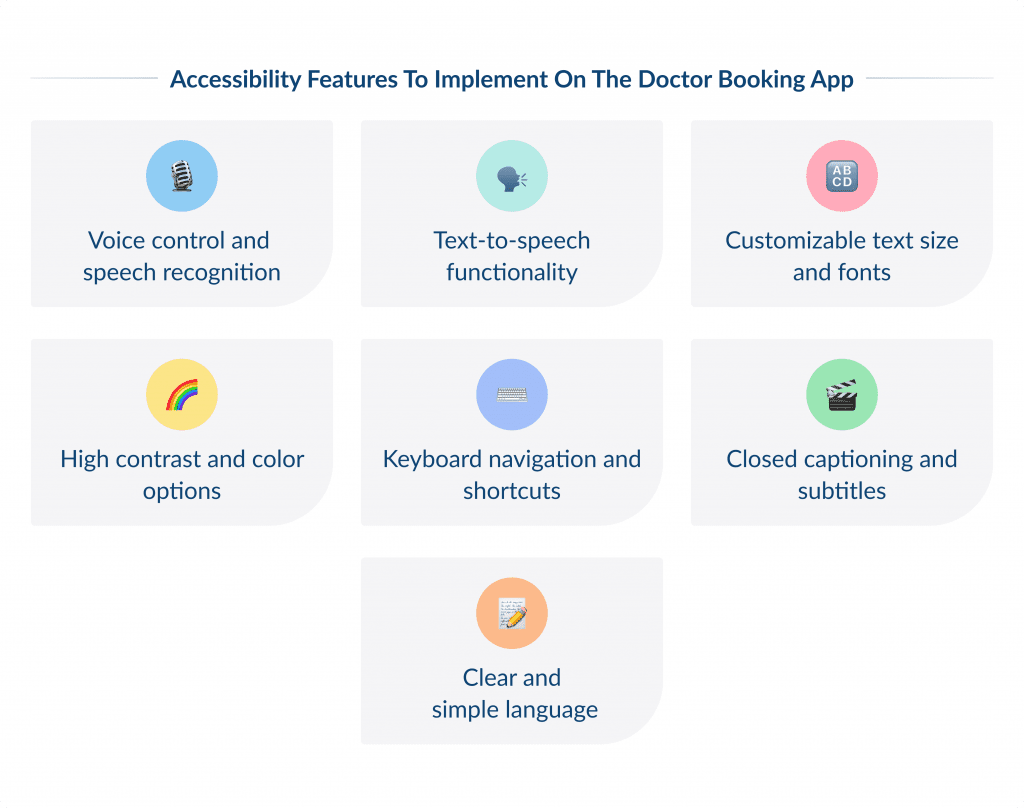
Innovation is the key to leadership. Here’s how to win the technology race in the healthcare industry.
Building Trust with Visual Elements
A transparent healthcare app design helps users understand exactly how their data is collected, stored, and used.
When healthcare apps present clear privacy policies in an easy-to-read format, it makes users feel more comfortable sharing their personal information.
In fact, IBM Security: 2023 Cost of a Data Breach Report shows that 81% of Americans are concerned about data privacy, which emphasizes the need for clarity and openness.
Implementing secure login processes, like multi-factor authentication, also plays a significant role in building trust.
When users know their health information is protected by strong security measures, they are more likely to feel safe using the app.
Furthermore, a user-friendly interface contributes to a trustworthy experience.
Together, simple navigation and intuitive design make it easier for users to find what they need without feeling overwhelmed.
According to Forrester’s The State Of Customer Obsession In Healthcare, 2022 survey, improving the overall user experience can increase loyalty by 15%. This is critical for healthcare apps in a crowded market.
Explore our guide to cybersecurity trends and see what your organization needs to stay secure.
The Development Process: A Step-by-Step Guide
When it comes to developing your own doctor appointment app, there is a specific step-by-step process you need to move on.
Here is how we approach the doctor appointment booking app at SpdLoad.
Step 1: Market Research and Competitor Analysis
We start off with thorough market research to grasp market dynamics and identify niches.
At this stage, our specialists work closely with your in-house team to gather vital information about potential competitors and their strategies.
This stage takes approximately 1-2 weeks.
Making the right choice is crucial. Here’s everything you need to know about in-house development vs. outsourcing.
Step 2: Defining Your Target Audience and Value Proposition
Another crucial step before diving into the doctor booking app development and design is defining the target audience and value proposition.
At this point, we gather characteristics like user demographics, behavior patterns, and specific healthcare needs.
These insights guide the development of customized features.
This stage takes around 1-2 weeks.
3. Development Planning
Now that we have the audience and value proposition nailed down, we plan the development lifecycle.
This document covers timelines, resource allocation and key milestones to keep the project on track.
A good plan helps us stay organized and ready for anything that comes up along the way.
It takes up to 2 weeks to plan and agree on the development lifecycle with the client.
4. App Design
In this phase, our design team brings the app to life visually.
We create wireframes and mockups that define the look and feel of the app.
We focus on intuitive design so users can navigate the app easily, which is key to keeping them engaged and happy with their experience.
The app design process phase takes 3-5 weeks.
5. Development
During the healthcare app development phase, we use an agile approach so we can adapt and evolve the app as we go.
This means we can incorporate user feedback and make changes in real time.
Regular sprints keep us moving forward and the app is continually refined to meet user expectations.
Development takes from 2 months to 8 months and more, depending on the app complexity.
6. Testing and QA
Testing is where we make sure everything works before we launch.
We test for any bugs, fix defects to make it more reliable and faster. This quality assurance process is crucial to deliver an app that users can trust.
Testing takes 2-4 weeks.
Testing is crucial to app success. Learn how to test a mobile app the right way.
7. Deployment and Live
Once testing is done, we share the app with the world!
We deploy it to app stores and make it available for download.
Once the app is launched, developers monitor for any issues and make sure everything is smooth.
We keep an eye on user feedback post launch to address any concerns ASAP.
Deployment and going live takes 1 week.
8. Post Launch and App Maintenance
The launch is just the beginning, not the end.
Ongoing support and maintenance is crucial to keep the app running smoothly.
This phase involves fixing user reported issues, updating content and refining features based on feedback.
Continuous maintenance ensures the app stays relevant and functional and adapts to user needs.
Following this step by step process we create a doctor appointment app that meets user needs and adapts to market changes.
Our agile development, thorough testing and ongoing support ensures your app will thrive in the healthcare space.
Find out how long it really takes to develop an app with our comprehensive guide on how long it takes to develop an app. 
Ready to build your app? Discover how to outsource mobile app development and work with top-notch experts.
Doctor Appointment App Development Cost
How much does it cost to develop a doctor appointment mobile app?
Unfortunately, we don’t have one clear answer for you.
The cost of developing a doctor appointment app depends on various factors. These include the app’s complexity, features, design, size of the development team, and team’s location.
Need a reliable development team? Here’s your step-by-step guide to hiring a dedicated team in Ukraine.
If you are looking for a quick answer, here you go: The cost of developing a doctor appointment app can range from $20,000 to $100,000 or more.
Although we said that the appointment app development costs vary depending on numerous factors, here is a rough idea of how much you may spend on the app development:
- A very basic doctor appointment booking app development cost can be around $20,000 to $30,000. This one has all the fundamental features required for basic functioning and has a basic design.
- For a medium doctor booking app with a few more features and modifications you will pay nearly $30,000-$60,000.
- The next category is the most complex form of the doctor booking app. You can get all the features you want your users to have, add complex customizations, get superior designs, and a lot more art for around $60,000 and higher.
Want to build a strong founding team? Start by learning how to find a technical co-founder.
Cost-Saving Strategies
You can save costs on doctor appointment mobile app development if you choose cross-platform tools like React Native or Flutter.
These tools allow developers to create apps that work on both iOS and Android using a single codebase.
If you’re planning to build an app, this detailed guide on Android app development costs will help you navigate the financial aspects.
And in case you wonder about iOS app development cost guide, our guide breaks it down.
This means you won’t have to pay for two separate development processes, saving both time and money.
Plus, with their growing communities, you can access plenty of resources and libraries to make your app functional and visually appealing without starting from scratch.
Another budget-friendly option is to use ready-made scheduling APIs like Acuity, Timekit, or OnSched.
Instead of building a scheduling system from the ground up, these APIs offer pre-built solutions that can easily integrate into your app.
This speeds up the development process and reduces the costs of building custom features.
Discover why healthcare IT outsourcing is becoming a game-changer for healthcare organizations.
Hiring the Right Development Team for Your Doctor Appointment App
The right development team is crucial for the successful doctor appointment app development.
If you have never worked with outsourcing companies before, it can be a tough process. But we’ve got you covered.
Here are a few tips on how to find the best outsourcing partner for developing doctor appointment apps (Discover the benefits of IT outsourcing and why it’s popular for scaling tech needs.).
First, you want to look for a team with experience in developing solutions for the healthcare industry.
Explore their case studies to see their field of expertise.
At SpdLoad, for example, we’ve been developing multiple solutions for the healthcare industry. We built mental health platforms, CRM systems for hospitals, telemedicine apps, and more.
Check out our case studies in healthcare to see what solutions we have already developed for our clients.
Another important aspect you want to ensure is that the team has a strong understanding of HIPAA regulations. Just ask them about how they make sure the apps they build are HIPAA-compliant.
Look for development companies that have experience in developing HIPAA-compliant apps and understand the regulations.
There is a high chance you won’t find the perfect match immediately, so it is better to schedule a brief intro call to discuss your project vision and see if the outsourcing company meets your expectations.
During this meeting, you want to evaluate their proactivity, transparency regarding costs, skills they possess, and terms of development.
It is also a good idea to check their reviews on Clutch and even ask for a quick review from their previous clients.
Need guidance on how to choose an app development company? This guide has you covered.
We are always happy to get in touch with you and explore the collaboration opportunities.
You can schedule a free consultation where we will discuss your idea, share our insights and see if our experience can benefit you.
Just drop us a line and we will get back to you soon.
Dreaming of creating a unicorn? Here’s how to find an idea for a unicorn startup.





